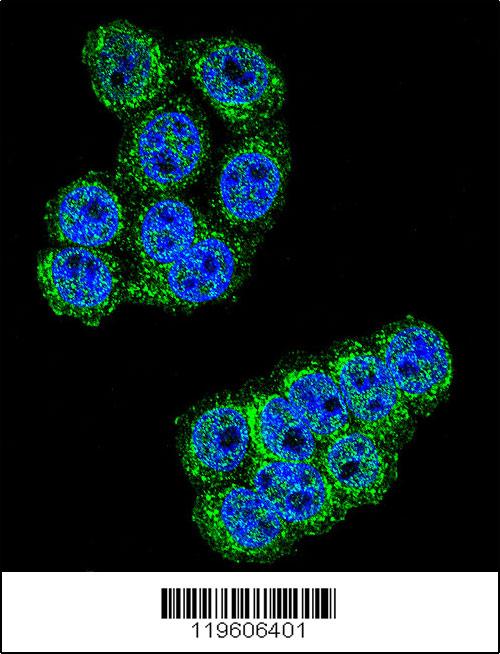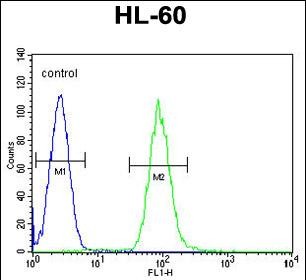DPP3 Antibody (C-term)
Affinity Purified Rabbit Polyclonal Antibody (Pab)
- SPECIFICATION
- CITATIONS
- PROTOCOLS
- BACKGROUND

Application
| IF, FC, WB, IHC-P, E |
|---|---|
| Primary Accession | Q9NY33 |
| Other Accession | Q99KK7, NP_005691 |
| Reactivity | Human |
| Predicted | Mouse |
| Host | Rabbit |
| Clonality | Polyclonal |
| Isotype | Rabbit IgG |
| Calculated MW | 82589 Da |
| Antigen Region | 583-612 aa |
| Gene ID | 10072 |
|---|---|
| Other Names | Dipeptidyl peptidase 3, Dipeptidyl aminopeptidase III, Dipeptidyl arylamidase III, Dipeptidyl peptidase III, DPP III, Enkephalinase B, DPP3 |
| Target/Specificity | This DPP3 antibody is generated from rabbits immunized with a KLH conjugated synthetic peptide between 583-612 amino acids from the C-terminal region of human DPP3. |
| Dilution | IF~~1:10~50 FC~~1:10~50 WB~~1:1000 IHC-P~~1:50~100 E~~Use at an assay dependent concentration. |
| Format | Purified polyclonal antibody supplied in PBS with 0.09% (W/V) sodium azide. This antibody is purified through a protein A column, followed by peptide affinity purification. |
| Storage | Maintain refrigerated at 2-8°C for up to 2 weeks. For long term storage store at -20°C in small aliquots to prevent freeze-thaw cycles. |
| Precautions | DPP3 Antibody (C-term) is for research use only and not for use in diagnostic or therapeutic procedures. |
| Name | DPP3 |
|---|---|
| Function | Cleaves and degrades bioactive peptides, including angiotensin, Leu-enkephalin and Met-enkephalin (PubMed:1515063, PubMed:3233187). Also cleaves Arg-Arg-beta-naphthylamide (in vitro) (PubMed:11209758, PubMed:3233187, PubMed:9425109). |
| Cellular Location | Cytoplasm, cytosol |
| Tissue Location | Detected in placenta (at protein level) (PubMed:3233187). Detected in erythrocytes (at protein level) (PubMed:1515063). |

Thousands of laboratories across the world have published research that depended on the performance of antibodies from Abcepta to advance their research. Check out links to articles that cite our products in major peer-reviewed journals, organized by research category.
info@abcepta.com, and receive a free "I Love Antibodies" mug.
Provided below are standard protocols that you may find useful for product applications.
Background
This gene encodes a protein that is a member of the M49 family of metallopeptidases. This cytoplasmic protein binds a single zinc ion with its zinc-binding motif (HELLGH) and has post-proline dipeptidyl aminopeptidase activity, cleaving Xaa-Pro dipeptides from the N-termini of proteins. Increased activity of this protein is associated with endometrial and ovarian cancers. Alternate transcriptional splice variants have been characterized.
References
Shukla, A.A., et al. FEBS J. 277(8):1861-1875(2010)
Salopek-Sondi, B., et al. Biol. Chem. 389(2):163-167(2008)
Gevaert, K., et al. Proteomics 5(14):3589-3599(2005)
Abramic, M., et al. Int. J. Biochem. Cell Biol. 36(3):434-446(2004)
Hillman, R.T., et al. Genome Biol. 5 (2), R8 (2004) :
If you have used an Abcepta product and would like to share how it has performed, please click on the "Submit Review" button and provide the requested information. Our staff will examine and post your review and contact you if needed.
If you have any additional inquiries please email technical services at tech@abcepta.com.













 Foundational characteristics of cancer include proliferation, angiogenesis, migration, evasion of apoptosis, and cellular immortality. Find key markers for these cellular processes and antibodies to detect them.
Foundational characteristics of cancer include proliferation, angiogenesis, migration, evasion of apoptosis, and cellular immortality. Find key markers for these cellular processes and antibodies to detect them. The SUMOplot™ Analysis Program predicts and scores sumoylation sites in your protein. SUMOylation is a post-translational modification involved in various cellular processes, such as nuclear-cytosolic transport, transcriptional regulation, apoptosis, protein stability, response to stress, and progression through the cell cycle.
The SUMOplot™ Analysis Program predicts and scores sumoylation sites in your protein. SUMOylation is a post-translational modification involved in various cellular processes, such as nuclear-cytosolic transport, transcriptional regulation, apoptosis, protein stability, response to stress, and progression through the cell cycle. The Autophagy Receptor Motif Plotter predicts and scores autophagy receptor binding sites in your protein. Identifying proteins connected to this pathway is critical to understanding the role of autophagy in physiological as well as pathological processes such as development, differentiation, neurodegenerative diseases, stress, infection, and cancer.
The Autophagy Receptor Motif Plotter predicts and scores autophagy receptor binding sites in your protein. Identifying proteins connected to this pathway is critical to understanding the role of autophagy in physiological as well as pathological processes such as development, differentiation, neurodegenerative diseases, stress, infection, and cancer.





